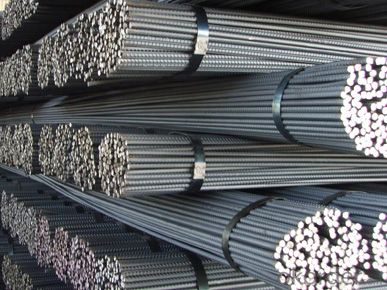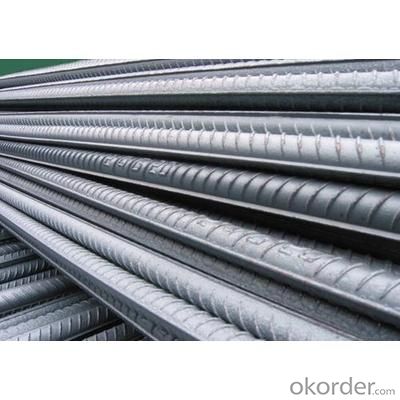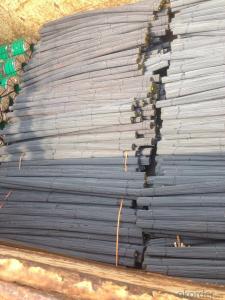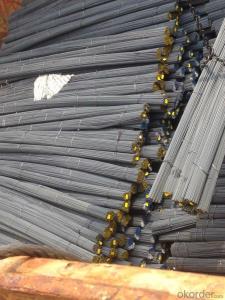Deformed Steel Bar with Reinforced Function for Construction
- Loading Port:
- Tianjin
- Payment Terms:
- TT OR LC
- Min Order Qty:
- 30 m.t.
- Supply Capability:
- 200000 m.t./month
OKorder Service Pledge
OKorder Financial Service
You Might Also Like
Item specifice
Product Description:
OKorder is offering Deformed Steel Bar with Reinforced Function for Constructionat great prices with worldwide shipping. Our supplier is a world-class manufacturer of steel, with our products utilized the world over. OKorder annually supplies products to European, North American and Asian markets. We provide quotations within 24 hours of receiving an inquiry and guarantee competitive prices.
Product Applications:
Deformed Steel Bar with Reinforced Function for Construction are ideal for structural applications and are widely used in the construction of buildings and bridges, and the manufacturing, petrochemical, and transportation industries.
Product Advantages:
OKorder's Deformed Steel Bar with Reinforced Function for Constructionare durable, strong, and resist corrosion.
Main Product Features:
· Premium quality
· Prompt delivery & seaworthy packing (30 days after receiving deposit)
· Corrosion resistance
· Can be recycled and reused
· Mill test certification
· Professional Service
· Competitive pricing
Product Specifications:
Standard | GB | HRB400 | |
Diameter | 6mm,8mm,10mm,12mm,14mm,16mm,18mm,20mm, 22mm,25mm,28mm,32mm,36mm,40mm,50mm | ||
Length | 6M, 9M,12M or as required | ||
Place of origin | Hebei, China mainland | ||
Advantages | exact size, regular package, chemical and mechanical properties are stable. | ||
Type | Hot rolled deformed steel bar | ||
Brand name | DRAGON | ||
Chemical Composition: (Please kindly find our chemistry of our material based on HRB500 as below for your information)
Grade | Technical data of the original chemical composition (%) | ||||||
C | Mn | Si | S | P | V | ||
HRB400 | ≤0.25 | ≤1.60 | ≤0.80 | ≤0.045 | ≤0.045 | 0.04-0.12 | |
Physical capability | |||||||
Yield Strength (N/cm²) | Tensile Strength (N/cm²) | Elongation (%) | |||||
≥400 | ≥570 | ≥14 | |||||
Theoretical weight and section area of each diameter as below for your information:
Diameter(mm) | Section area (mm²) | Mass(kg/m) | Weight of 12m bar(kg) |
6 | 28.27 | 0.222 | 2.664 |
8 | 50.27 | 0.395 | 4.74 |
10 | 78.54 | 0.617 | 7.404 |
12 | 113.1 | 0.888 | 10.656 |
14 | 153.9 | 1.21 | 14.52 |
16 | 201.1 | 1.58 | 18.96 |
18 | 254.5 | 2.00 | 24 |
20 | 314.2 | 2.47 | 29.64 |
22 | 380.1 | 2.98 | 35.76 |
25 | 490.9 | 3.85 | 46.2 |
28 | 615.8 | 4.83 | 57.96 |
32 | 804.2 | 6.31 | 75.72 |
36 | 1018 | 7.99 | 98.88 |
40 | 1257 | 9.87 | 118.44 |
50 | 1964 | 15.42 | 185.04 |
Usage and Applications of Deformed Steel Bar with Reinforced Function for Construction:
Deformed bar is widely used in buildings, bridges, roads and other engineering construction. Big to highways, railways, bridges, culverts, tunnels, public facilities such as flood control, dam, small to housing construction, beam, column, wall and the foundation of the plate, deformed bar is an integral structure material. With the development of world economy and the vigorous development of infrastructure construction, real estate, the demand for deformed bar will be larger and larger..
Packaging & Delivery ofDeformed Steel Bar with Reinforced Function for Construction:
Packaging Detail: products are packed in bundle and then shipped by container or bulk vessel, deformed bar is usually naked strapping delivery, when storing, please pay attention to moisture proof. The performance of rust will produce adverse effect.
Each bundle weight: 2-3MT, or as required
Payment term: TT or L/C
Delivery Detail: within 45 days after received advanced payment or LC.
Label: to be specified by customer, generally, each bundle has 1-2 labels
Trade terms: FOB, CFR, CIF
Images of Deformed Steel Bar with Reinforced Function for Construction
I


Note:
1. Our products are produced according to national standard (GB), if not, supply according to national standards (GB) or agreement as customer required.
2. Other Grade and Standard Deformed Steel Bar we can supply:
Grade: GR40/GR60, G460B/B500A/B500B/B500C,BST500S
Standard: ASTM, BS, DIN
The Minimum Order Quantity of these products is high, and need to be confirmed.
3. We can not only supply Deformed Steel Bar; if you need anything about building materials, please contact us for further information.
4. Please send us your detail specifications when inquire. We will reply to you as soon as possible. We sincerely hope we can establish a long stable business relationship.
FAQ:
Q1: How soon can we receive the product after purchase?
A1: Within three days of placing an order, we will begin production. The specific shipping date is dependent upon international and government factors, but is typically 7 to 10 workdays.
Q2: What makes stainless steel stainless?
A2: Stainless steel must contain at least 10.5 % chromium. It is this element that reacts with the oxygen in the air to form a complex chrome-oxide surface layer that is invisible but strong enough to prevent further oxygen from "staining" (rusting) the surface. Higher levels of chromium and the addition of other alloying elements such as nickel and molybdenum enhance this surface layer and improve the corrosion resistance of the stainless material.
- Q:How do steel rebars contribute to the crack control in concrete structures?
- Steel rebars contribute to crack control in concrete structures by providing reinforcement and increasing the tensile strength of the concrete. Concrete is strong in compression but weak in tension, so when subjected to tensile forces, it tends to crack. By embedding steel rebars within the concrete, these cracks are minimized, as the rebars distribute the tensile forces and prevent them from causing large cracks. The rebars also help to hold the concrete together, providing additional support and preventing the propagation of cracks. Overall, steel rebars enhance the overall structural integrity and durability of concrete structures by effectively controlling and limiting cracks.
- Q:Are there any codes or regulations for the use of steel rebars in construction?
- Steel rebars in construction are subject to codes and regulations to ensure their proper use. Guidelines and standards are provided by organizations like the American Concrete Institute (ACI) in the United States. The ACI 318 Building Code Requirements for Structural Concrete outlines specific requirements for the size, placement, and quality of rebars. Similar regulations can be found in the widely adopted International Building Code (IBC), which governs construction practices in different jurisdictions. It includes provisions and references to standards that dictate the use of rebars in reinforced concrete structures. Different countries also have their own standards organizations, such as the British Standards Institution (BSI) in the United Kingdom. These organizations have their own codes and regulations for the use of rebars in construction. These codes and regulations are crucial for ensuring the safety and longevity of structures. They establish requirements for rebars' size, grade, and placement, as well as provide guidelines for designing, detailing, and constructing reinforced concrete elements. Adhering to these codes and regulations guarantees that structures can withstand anticipated loads and perform as intended.
- Q:Can steel rebars be used in buildings with high architectural requirements?
- Yes, steel rebars can be used in buildings with high architectural requirements. Steel rebars are widely used in construction due to their strength, durability, and versatility. They provide structural integrity and reinforcement to concrete structures, making them suitable for a wide range of architectural designs and requirements. Steel rebars can be used in various architectural elements, such as beams, columns, walls, slabs, and foundations. They can be bent, shaped, and welded to meet specific architectural designs, allowing for intricate and complex structures. Additionally, they can be customized in terms of size, length, and spacing, ensuring that they meet the architectural requirements of the building. Moreover, steel rebars are resistant to fire, corrosion, and extreme weather conditions, making them suitable for buildings with high architectural requirements in terms of safety and durability. They provide a long-lasting solution, ensuring that the architectural vision and design can be preserved for years to come. In conclusion, steel rebars can definitely be used in buildings with high architectural requirements. Their strength, durability, versatility, and customization options make them an ideal choice for ensuring structural integrity while meeting the aesthetic and design requirements of the building.
- Q:How are steel rebars installed in concrete slabs?
- The process of reinforcing concrete slabs involves the installation of steel rebars. These rebars are placed in a specific pattern within the concrete slab to provide additional strength and support. To begin, the area where the concrete slab will be poured is prepared by excavating and leveling the ground. A layer of compacted gravel or crushed stone, known as the base, is then placed to create a stable foundation. Once the base is in place, the rebars are positioned within the slab according to the desired locations. Typically, they are arranged in a grid-like pattern, with horizontal rebars placed parallel to each other and vertical rebars placed perpendicular to the horizontal ones. The spacing and diameter of the rebars depend on the design requirements and load capacity. To ensure proper positioning, plastic bar supports or chairs are used to lift the rebars off the ground and hold them in place. Additionally, the rebars are tied together at the intersections using wire or metal ties to maintain their relative positions during the concrete pouring process. After the rebars are properly positioned, the concrete is poured over them. The concrete mixture is carefully spread evenly across the entire area of the slab, fully encasing the rebars. Vibrating tools may be utilized to eliminate air bubbles and consolidate the concrete around the rebars. Once the concrete is poured, it is left to cure and harden. During this time, the rebars provide reinforcement, increasing the strength and load-bearing capacity of the slab. Once fully cured, the concrete slab with embedded rebars becomes a durable and structurally sound element capable of withstanding various loads and stresses. In conclusion, the installation of steel rebars in concrete slabs involves positioning them in a grid-like pattern and pouring the concrete over them. This reinforcing process enhances the strength and durability of the slab, making it suitable for a wide range of applications.
- Q:How do steel rebars affect the overall crack control of concrete?
- Steel rebars play a crucial role in controlling cracks in concrete structures. The incorporation of steel rebars in concrete significantly enhances its tensile strength, which is otherwise quite low. When concrete undergoes tensile forces, such as those caused by drying shrinkage, temperature changes, or applied loads, it tends to crack. However, the presence of steel rebars helps to mitigate and control these cracks. Rebars act as reinforcement, providing additional strength to the concrete. They resist the tensile forces, preventing the concrete from easily cracking. When tensile forces are applied to the reinforced concrete, the rebars carry a significant portion of the load, reducing the stress on the concrete and minimizing crack formation. Moreover, the bond between the steel rebars and the concrete is integral in crack control. The bond ensures that the rebars effectively transfer the tensile forces to the concrete, enhancing its overall crack resistance. This bond also helps in distributing the applied loads evenly and reducing the risk of localized cracking. Furthermore, steel rebars can also be used to control crack widths in concrete. By specifying the appropriate diameter, spacing, and arrangement of the rebars, engineers can influence the crack widths to meet design requirements. The rebars act as barriers, limiting the width of cracks that may occur, thus maintaining the structural integrity of the concrete. In summary, steel rebars have a positive impact on the overall crack control of concrete. They enhance the tensile strength of concrete, resist tensile forces, distribute applied loads, and limit crack widths. By incorporating steel rebars in concrete, engineers can ensure the durability and longevity of concrete structures by effectively controlling crack formation and minimizing their negative consequences.
- Q:Can steel rebars be used in structures with high sulfate content in soil or water?
- Steel rebars should generally not be used in structures with high sulfate content in soil or water. Sulfates can react with the steel and cause it to corrode rapidly, leading to structural damage and potential failure. To mitigate this risk, alternative materials such as stainless steel or fiber-reinforced polymer rebars may be recommended for use in such environments.
- Q:Are there any specific guidelines for storing steel rebars on-site?
- Yes, there are specific guidelines for storing steel rebars on-site. These guidelines typically include keeping the rebars off the ground using racks or pallets, ensuring proper alignment and support to prevent bending or warping, protecting them from moisture and corrosion by covering with waterproof material, and organizing them in a way that allows easy access and identification. It is also important to follow any manufacturer recommendations and local building codes for safe storage of steel rebars.
- Q:How are steel rebars measured?
- Steel rebars are measured using a standardized system known as the "bar size number." This system assigns a numerical value to each rebar size, which corresponds to the diameter of the rebar. The diameter is measured in inches or millimeters, depending on the region or country. In the United States, the bar size number is used, which ranges from #3 to #18. The number indicates the diameter of the rebar in eighths of an inch. For instance, a #3 rebar has a diameter of 3/8 inch, while a #8 rebar has a diameter of 1 inch. Beyond #8, the diameter is measured in quarters of an inch. For example, a #11 rebar has a diameter of 1 1/8 inches, and a #18 rebar has a diameter of 2 1/4 inches. In metric countries, rebars are measured using millimeters. The diameter is typically rounded to the nearest millimeter. For instance, a 10 mm rebar is equivalent to a #3 rebar in the US, and a 25 mm rebar is equivalent to a #8 rebar. To measure the length of a rebar, a tape measure or ruler is used. The length is typically measured in feet or meters. Rebars are commonly available in lengths of 20 or 40 feet (6 or 12 meters), but they can also be cut to custom lengths as per project requirements. It is important to note that the measurement system may vary slightly in different regions or countries, so it is crucial to consult local standards and codes for accurate measurement guidelines.
- Q:Can steel rebars be used in structures exposed to aggressive chemicals?
- No, steel rebars should not be used in structures exposed to aggressive chemicals as they are susceptible to corrosion and may weaken over time, compromising the integrity of the structure.
- Q:What is the role of steel rebars in reinforced concrete walls?
- Steel rebars play a crucial role in reinforced concrete walls by providing tensile strength and reinforcing the structure. They help resist applied forces such as tension, bending, and shearing, making the concrete walls more durable and able to withstand external loads.
1. Manufacturer Overview |
|
|---|---|
| Location | |
| Year Established | |
| Annual Output Value | |
| Main Markets | |
| Company Certifications | |
2. Manufacturer Certificates |
|
|---|---|
| a) Certification Name | |
| Range | |
| Reference | |
| Validity Period | |
3. Manufacturer Capability |
|
|---|---|
| a)Trade Capacity | |
| Nearest Port | |
| Export Percentage | |
| No.of Employees in Trade Department | |
| Language Spoken: | |
| b)Factory Information | |
| Factory Size: | |
| No. of Production Lines | |
| Contract Manufacturing | |
| Product Price Range | |
Send your message to us
Deformed Steel Bar with Reinforced Function for Construction
- Loading Port:
- Tianjin
- Payment Terms:
- TT OR LC
- Min Order Qty:
- 30 m.t.
- Supply Capability:
- 200000 m.t./month
OKorder Service Pledge
OKorder Financial Service
Similar products
New products
Hot products
Related keywords





























